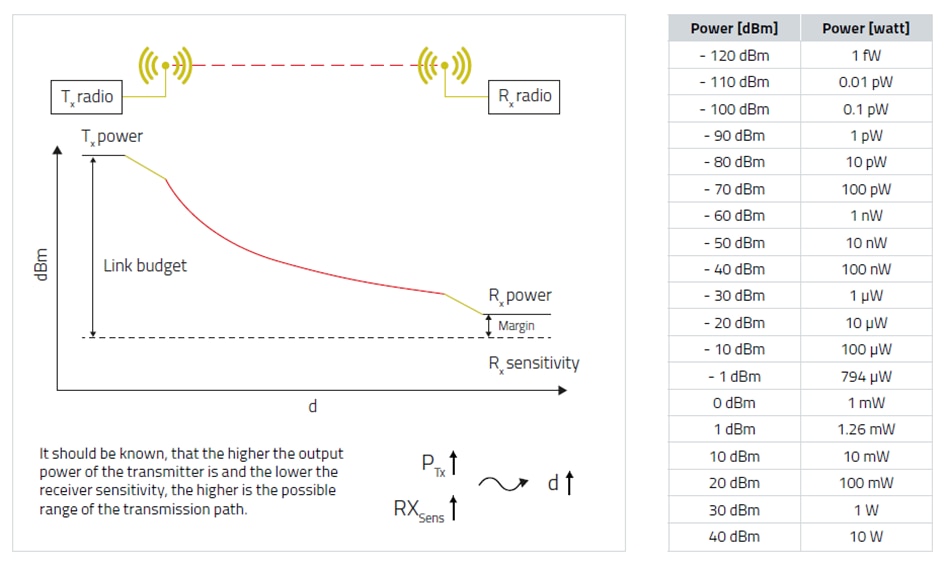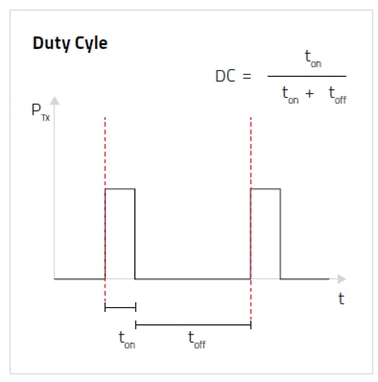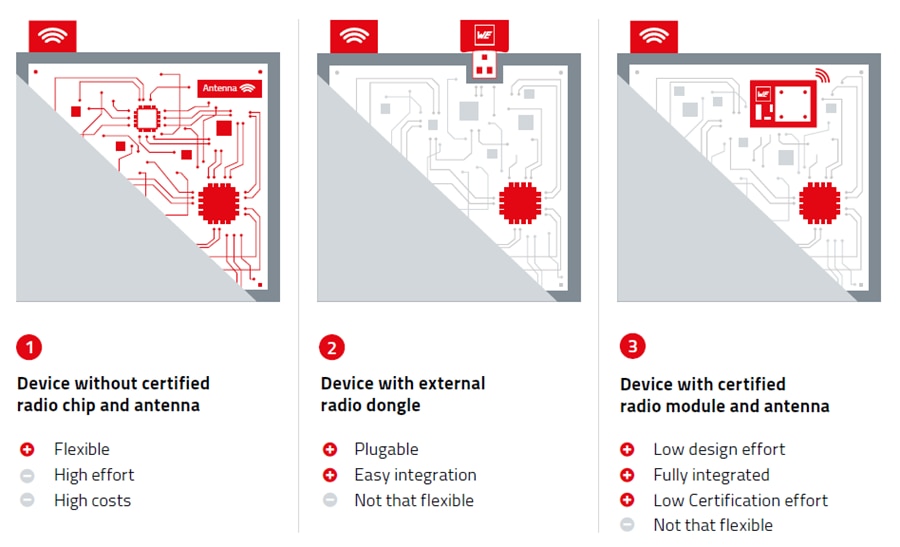Fundamentals
Radio communication
The History of Radio Technology
Radio technology is a wireless method of transmitting signals by means of modulated electromagnetic waves. In 1884 James Clerk Maxwell predicted the existence of radio waves, which was experimentally confirmed by Heinrich Hertz on November 11th, 1886.
There are five main key facts, which have to be considered:
- Transmission of the Signal
- Link Budget
- Duty Cycle
- Access
- Integration of Radio Technology
1. Transmission of the Signal
For the Transmission the signal will be modulated on a carrier signal, mostly sinus with constant amplitude. Thereby the amplitude or frequency will be adopted in the rhythm of the transmitted signal. The modulated wave is radiated by an antenna and received on the otherside with an antenna too. Due to demodulation at the receiver the transmitted signal can be used.

Range Estimation
When a radio connection is planned, the given circumstances define largely the requirements for radio range, operating temperature and available space.
ANR010 Range Estimation www.we-online.com/ANR010


Conclusion
In a lot of cases there is the need of long distances with regard to the antenna height, so usually the two ray ground model is a good fitting estimation. Only for some special cases with the free space condition fulfilled the Friis model is useful. Having a closer look to the models there are several interesting points to mention.
The Dependency of the Frequency
Often it is mentioned in general, that the lower the frequency is, the greater the range is. We have learned, that this is only the case when free field conditions are met. But there are other effects of the frequency, as the fact, that for higher frequencies smaller objects will cause reflections, or that for low frequencies it might be hard to find an antenna with acceptable size and efficiency.
The Influence of the Antenna Height on the Range
The higher the antennas can be placed, the longer is the range that can be reached. Placing an antenna directly above ground reduces the range so radical, a layman could hardly imagine.
2. Link Budget (power of the carrier)
A link budget is an accounting of all of the power gains and losses that a communication signal experiences in a telecommunication system; from a transmitter, through a medium (free space, cable, waveguide, fiber, etc.) to the receiver. It is an equation giving the received power from the transmitter power, after the attenuation of the transmitted signal due to propagation, as well as the antenna gains and feedline and other losses, and amplifications of the signal in the receiver or any repeaters it passes through.

3. Duty Cycle
A duty cycle or power cycle is the fraction of one period in which a signal or system is active. Duty cycle is commonly expressed as a percentage or a ratio. A period is the time it takes for a signal to complete an on-and-off cycle. E.g. using a duty cycle of 10 %, means that the used transmitter is allowed to send 6 minutes in between one hour.

4. Polite Spectrum Access – listen before talk
When an application uses polite spectrum access, the duty cycle restrictions are loosened. Polite spectrum access encompasses two aspects: Listen Before Talk (LBT) and Adaptive Frequency Agility (AFA). LBT defines that the device must listen if the medium is already in use by a Clear Channel Assessment (CCA) check. When the medium is in use, the device must wait a random backoff interval or change the frequency before checking again. The latter is called AFA.
5. Integration of Radio Technology
One of the last steps before a product with integrated wireless technology can be launched on the market is the certification. Manufacturers of products with integrated RF-technology may only market these with the necessary certification. The following graphics display the three options which are available for integrating wireless technology.

See more:
- CERTIFICATION & CONFORMITY
- WHY USING A RADIO MODULE?
- IMPROVE YOUR DESIGN GET RID OF NOISE
- CELLULAR
- CELLULAR: IOT CONNECTIVITY OPTIONS
- BLUETOOTH® OVERVIEW
- BLUETOOTH® STANDARTS & VERSIONS
- BLUETOOTH®︎ LOW ENERGY IN GENERAL
- BLUETOOTH® SPECIAL INTEREST GROUP (SIG)
- WIFI INTRODUCTION
- PROPRIETARY INDUSTRY PROVEN & LICENSE FREE
- SHORT RANGE DEVICE FREQUENCY BANDS
- PROPRIETARY RADIO STACK
- MESH INTRODUCTION AND OVERVIEW
- WIREPAS MASSIVE
- BLUETOOTH® MESH
- USER APPLICATION INDUSTRIAL IOT
- WIRELESS M-BUS INTRODUCTION
If you want to read more find here the whole Product Guide.

